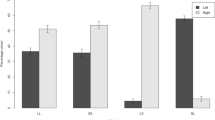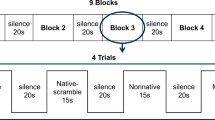Abstract
Two experiments involving listening preferences of autistic and normal subjects were conducted to test the hypothesis that the right cerebral hemisphere is more active than the left hemisphere in autistic children. Results showed that when given a choice between verbal and musical material, the autistic children preferred music, while normal children showed no preference. Secondly, autistic children listened to both types of material predominantly with the left ear. Although normal subjects showed greater variation among themselves, they tended to listen to music more often with the left ear and to listen to verbal material more often with the right. These results support the notion that some autistic children are predominantly righthemisphere processors.
Similar content being viewed by others
Reference notes
Entus, A. K.Hemispheric asymmetry in processing of dichotically presented speech and nonspeech stimuli in infants. Paper presented at the Biennial Meeting of the Society for Research in Child Development, Denver, April 1975.
Harris, L. J.Interaction of experiential and neurological factors in the patterning of human abilities: The question of sex differences in right hemisphere skills. Paper presented at the symposium on Functional specialization of the cerebral hemispheres in infants and children: New experimental and clinical evidence, at the Biennial Meetings of the Society for Research in Child Development, Denver, April 1975.
References
Bever, T. G., & Chiarello, R. J. Cerebral dominance in musicians and non-musicians.Science, 1974,185, 537–539.
Bogen, J. E. The other side of the brain. II. An appositional mind.Bulletin of the Los Angeles Neurological Societies, 1969,34, 135–162.
Bogen, J. E., & Gazzaniga, M. Cerebral commisurotomy in man: Minor hemisphere dominance for certain visuo-spatial functions.Journal of Neurosurgery, 1965,23, 394–399.
Colby, K. M., & Parkison, C. Handedness in autistic children.Journal of Autism and Childhood Schizophrenia, 1977,7, 3–9.
Condon, W. S. Multiple response to sound in dysfunctional children.Journal of Autism and Childhood Schizophrenia, 1975,5, 37–56.
Condon, W. S., & Lander, L. W. Neonate movement is synchronized with adult speech: Interactional participation and language acquisition.Science, 1974,183, 99–101.
Davis, A. E.,& Wada, J. A. Hemispheric asymmetries in human infants.Brain and Language, 1977,4, 23–31.
Ehrlichman, H., Weiner, S., & Baker, A. H. Effects of verbal and spatial questions on initial gaze shifts.Neuropsychology, 1974,12, 265–277.
Eimas, P. D., Siqueland, E. R., Jusczyk, P., & Vigorito, J. Speech perception in infants.Science, 1971,171, 303–306.
Gates, A., & Bradshaw, J. L. The role of cerebral hemispheres in music.Brain and Language, 1977,4, 403–431.
Gazzaniga, M.The bisected brain. New York: Appleton-Century-Crofts, 1970.
Hammer, M., & Turkewitz, G. A sensory basis for the lateral difference in the newborn infant's response to somesthetic stimulation.Journal of Experimental Child Psychology, 1974,18, 304–312.
Hauser, S. L., DeLong, G. R., & Rosman, N. P. Pneumographic findings in the infantile autism syndrome.Brain, 1975,98, 667–688.
Hermelin, B., & O'Connor, N. Visual imperception in psychotic children.British Journal of Psychology, 1965,56, 455–460.
Hollander, F. M., & Juhrs, P. D. Orff-Schulwerk: An effective treatment tool with autistic children.Journal of Music Therapy, 1974,11, 1–12.
18Kanner, L. Follow-up study of eleven autistic children.Journal of Autism and Childhood Schizophrenia, 1971,1, 119–145.
Kimura, D. The asymmetry of the human brain.Scientific American, 1973,228, 70–78.
Kinsbourne, M. Eye and head turning indicate cerebral lateralization.Science, 1972,176, 539–541.
Kinsbourne, M. The control of attention by interaction between the cerebral hemispheres. In S. Kornblum (Ed.),Attention and performance (Vol. 4). New York: Academic Press, 1973. (a)
Kinsbourne, M. The mechanism of hemispheric control of the lateral gradient of attention. In P. M. A. Rabbitt & S. Dornic (Eds.),Attention and performance (Vol. 5). New York: Academic Press, 1973. (b)
Kinsbourne, M. Direction of gaze and distribution of cerebral thought processes.Neuropsychologia, 1974,12, 279–281.
Kohn, B., & Dennis, M. Patterns of hemispheric specialization after hemidecortication for infantile hemiplegia. In M. Kinsbourne & W. L. Smith (Eds.),Hemispheric disconnection and cerebral function. Springfield, Illinois: Charles C Thomas, 1974.
Landsdell, H. Relation of extent of temporal lobe removals to closure and visuomotor factors.Perceptual and Motor Skills, 1970,31, 491–498.
Lockyer, L., & Rutter, M. A five- to fifteen-year follow-up study of infantile psychosis. 4. Patterns of cognitive ability.British Journal of Social and Clinical Psychology, 1970,9, 152–163.
Piaget, J.Introduction à l'epistémologie génétique (3 vols.). Paris: Presses Universitaires de France, 1950.
Ritvo, S., & Provence, S. Form perception and imitation in some autistic children: Diagnostic findings and their contextual interpretation.Psychoanalytic Study of the Child, 1953,8, 153–161.
Rutter, M. Concepts of autism: A review of research.Journal of Child Psychology and Psychiatry and Allied Disciplines, 1968,9, 1–25.
Rutter, M. The development of infantile autism.Psychological Medicine, 1974,4, 147–163.
Tanguay, P. Clinical and electrophysiological research. In E. Ritvo (Ed.),Autism: Diagnosis, current research and management. New York: Spectrum Publications, 1975.
Turkewitz, G. The detection of brain dysfunction in the newborn infant. In D. P. Purpura & G. P. Reaser (Eds.),Methodological approaches to the study of brain maturation and its abnormalities. Baltimore: University Park Press, 1972.
Wing, J. K. Diagnosis, epidemiology, etiology. In J. K. Wing (Ed.),Early childhood autism. Oxford: Pergamon Press, 1966.
Witelson, S. F., & Pallie, A. Left hemisphere specialization for language in the newborn: Neurological evidence of asymmetry.Brain, 1973,96, 641–646.
Author information
Authors and Affiliations
Rights and permissions
About this article
Cite this article
Blackstock, E.G. Cerebral asymmetry and the development of early infantile autism. J Autism Dev Disord 8, 339–353 (1978). https://doi.org/10.1007/BF01539636
Issue Date:
DOI: https://doi.org/10.1007/BF01539636




